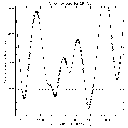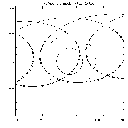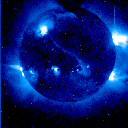 |
980110
: The coherent dimming of the entire corona
Coherent coronal dimming is hinted at by the continuous exponential decay
of the GOES plot. Rather than the occultation of an active
region by the Sun's limb, could it be the coherent decay of the many dim
regions in the absence of new coronal flux injection? |
 |
980117
: The curiously smooth emergence of AR8131
This active region showed initial x-ray brightening of stable structures
without any obvious flaring. The initial behavior of AR8131 is rather
inconsistent with the usual picture. The solution lay in the SXT
image, showing two separate emergences. |
 |
980124
: A typical data request
The Yohkoh chief observer often gets requests about data at specific times
of interest to somebody. In this case the request dealt with an IPS
phenomenon seen on 12 Jan. 1998 but shows only effects attributable to
solar rotation and the normal coming and going of miscellaneous things. |
 |
980131
: The X-ray Doppler Telescope (XDT)
The XDT rocket consists of an innovative X-ray telescope with narrow pass
bands in the red and blue wings of the Fe XIV emission line, enabling it
to measure the coronal 'line of sight' velocity field. From an SXT
perspective, its success has been an important step scientifically. |
 |
980207
: A peaceful day on the X-ray Sun
The solar activity was very low this week, much like during solar minimum.
However, there were some nice eruptive events, which did not produce much
X-ray emission. News of a successful XDT launch accompanied news
of further SXT entrance filter deterioration. |
 |
980214
: Observations of expanding Active Region loops
The SXT collaborated with SOHO in observing the expansion of coronal loops
in the outer portions of active regions. SXT observed slow motion
(10-30 km/s) in AR 8151, however it remains for Doppler analysis to show
whether this is plasma motion or the successive brightening of loops. |
 |
980221:
Refinement of Eclipse planning
The SXT plans for the YOHKOH partial Solar eclipses. A series of
rapid quarter resolution (256x256) full sun images and partial images will
hopefully show grazing occultation of any active regions that are present
at that time.. |
 |
980227
: An X-ray Solar eclipse
The highlight this week was of course the solar eclipse. Partial-Sun
images 10 seconds apart were acquired of a small active region just on
the edge of the moon's apparent path. Available are full-Sun movies
of the eclipse to view. |

|
980306
: An extraordinarily high latitude region
This week saw an extremely large-scale postflare loop system that apparently
arose in an active region just crossing the E limb at the amazing latitude
N48. It is seen edge on and was probably associated with a massive
CME projected outwards to the side. |
 |
980313
: Loops interconnecting same-hemisphere active regions
These loops interconnect two high latitude active regions in the south,
one region of which produces an M class flare. After the flare the
interconnecting loops change into loops that seem to have evolved via some
subtle mechanism associated with the energy released from the flare. |
 |
980320
: A stable filament channel with a hot core
A retrospective nugget examining the unusually stable filament structure
that was clearly visible for 3 rotations in July 1997. The core of
this structure is clearly x-ray hot. This phenomena is rarely observed
since it needs to acquire a special orientation. |
 |
980327
: AR dependence on flare characteristics
During 22-27 March 1998, there was one flare a day that was more intense
than C5. Although not comprehensively covered by YOHKOH they seemed
to vary according to their region, producing cusps, or not. |

|
980403
: Message from the back side of the Sun
Emission from the Southern limb, presumably due to a large region on the
back side of the Sun, was observed to be occasionally dynamic. When
the region rotated into view it was no longer at high latitudes suggesting
a dynamic nature. |
 |
980410
: Further analysis of the 7-Apr-97 CME Flare
This major event demonstrates the characteristic sigmoid signature of a
preflaring active region. This region was also comprehensively covered
by the EIT, and joint analysis at the SoHO-Yohkoh Workshop at ISAS proved
particularly insightful. |

|
980417
: Growth and Decay of AR 8203
We notice four C6-9 flares around 15-Apr-98, all from region AR 8203.
The region eventually appeared to exhaust itself in the succession of flares,
one of which was associated with a CME as observed by LASCO. |
 |
980424
: Proton flare of April 20
Excellent coverage by SXT of this flare, including the pre-flare event
before SXT switched automatically to flare mode coverage. |
 |
980508
: M flare ejecta and Loop filling
Yohkoh successfully observed the M class flare from region NOAA 8210 that
threw off material. This is viewable as movies taken in SXT's flare
mode and also graphically demonstrates the filling of coronal loops near
the flare origin. |
 |
980515
: Observations by a Solar spacecraft Flotilla
A unique opportunity to make coincident observations by three telescopes
(Yohkoh, SoHO and TRACE) of the same Solar region. This week saw
plenty of activity including M class flares and the rather extraordinary
failure of a massive arcade to erupt. |
 |
980522
: Filament channel seen in many wavelengths
This week we examine a filament channel that is currently on the southeast
limb. By exploiting many different wavelength images, including SOHO
EIT, it is shown that the filament as lying in a channel outlined by bright
edges. |
 |
980529
: Connecting structure between distant Active Regions
We again encounter a large connecting magnetic structure spanning the gap
between two ARs. It appears to fluctuate in brightness over several
days, betraying its persistent presence. Whether it formed from smaller
structures is not clear, but you can see a movie of this phenomenon. |
 |
980605
: Cycle variation of X-ray Bright Points (XBPs)
SXT has observed XBPs since 1993. It has been found that the number
of XBPs doesn't appear to follow the number of sunspots. Accounting
for bright sunspots drowning out dim XBPs, it appears that the generative
dynamos for XBPs and sunspots differ dramatically. |
 |
980612
: A Sigmoidal Learning Curve
All is revealed in this nugget which shows the complete coverage of a CME,
from the initial S shaped sigmoidal signature to the Geomagnetic interaction
as the Earthward bound ejecta reaches the Earth. Successful prediction
of these events is one of the motivations behind the Yohkoh. |

|
980619
: The sigmoid that wouldn't quit
A collection of movies that act as a follow-up to last week's dramatic
exhibition. The sigmoid remnants from last weeks eruption showed
further eruption potential. Indeed the region once again erupted
behind the Southwest limb of the Sun, the event being captured by SXT and
LASCO. |
 |
980626
: X-ray transit of Mercury
Yohkoh observes the first X-ray transit of Mercury. The observations
were used, firstly, to calibrate the SXT and HXT roll positions, and secondly
to look for scattered light, since the disc of Mercury should, in principle,
appear to be a completely black object. |
 |
980704
: Images of the X2 flare of May 2, 1998
The SXT helps observes this very powerful flare. Before eruption
two symmetrical but strongly tilted arcs are seen, these seem to vanish
as the flare proceeds to erupt. The ejection is interestingly non-radial
initially, but probably straightens out at later times. |
 |
980711
: An amazing triple jet
Three simultaneous jets is an extremely rare occurrence. They exhibit
similar properties, although one seems to have excited a longer lived loop
structure. This all leaves questions as to the mechanism behind this
simultaneity and the relation between the corona and the jet shapes. |
 |
980718
: Global connectivity
A retrospective nugget from when the sun was at a solar minimum.
At that time active regions were embedded in a quiet corona, devoid of
large X-ray features. This allowed a less confusing study of this
flux emergence. |
 |
980725
: Global CME manifestation in X-rays
Another retrospective account, this time of the CME of 5th Oct 1996.
This event occupied nearly the entire western hemisphere, originating from
a region beyond the limb. Large scale dimming accompanied the CME
which caused some of the most widespread events seen by the SXT. |
 |
980801
: Active region seen by SXT and TRACE
The combined efforts of the two telescopes sought to identify the signatures
of magnetic flux emergence in Active Regions. Coordinated exercises
like these are rare but are important in clarifying the mechanisms behind
coronal loop heating.. |
 |
980808
: Hida Campaign - Jet observed by SXT and TRACE
Another nugget dedicated to the search for magnetic flux emergence.
The signatures of which include arch filament systems (AFSs), surges, X-ray
jets and loop brightenings. These images show a jet, coming from
a nicely cusped active region. |
 |
980815
: WSF Campaign - Loop brightening observed by SXT and TRACE
The beginning of the Whole Sun Fortnight campaign targeted the magnetic
field and coronal morphologies of two active regions in the northern hemisphere.
They exhibit developing loop brightening as shown by the TRACE and SXT
images. |
 |
980822
: An X4 Eruptive Flare
This week Yohkoh comprehensively observed several X class flares from a
single Active Region. Accompanying this event was a significant reconfiguration
of the coronal surrounding region. This reconnection may be followed
in a movie. |
 |
980829
: Solar eclipse as seen by the Yohkoh spacecraft
Yohkoh observed four episodes of the solar eclipse that could be seen in
SE Asia on 22 August 1998. The apparent complicated motion of the
moon is due to Yohkoh's orbital motion around the Earth . |

|
980905
: Proton flare in AR 8210
This nugget follows the two week period of progressively intensifying flares
that began in late April. Yohkoh observers examine one such flare,
noting its eruptive nature and lack of an impulsive signature in the hard
X-ray time profiles. |
 |
980912
: Geometry of flare loops
The appearance of loops projected onto the image plane is considered mathematically.
Demonstrating the progressively complex nature of more realistic models.
this work is important in describing how these loops are heated. |
 |
980919
: An over-the-limb event
This LDE originated from a large Active Region beyond the limb. This
event is interesting as it involves a large arcade, which are usually associated
with CMEs. In such an event coronal dimming is observed. These
observations show such effects. |
 |
980926
: Emerging flux and coronal activity
Emergent flux is observed as Arch Filament Systems (AFSs) near active regions,
these draw photospheric material out into the corona. When seen in
different wavebands the effects of these AFSs do not coincide spatially,
perhaps implying a complex heating interaction with the corona. |
 |
981002
: A Compact Loop-top Source
This nuggets examines the top region of a M class solar flare near the
solar limb. A SOHO-EIT image shows a bright source at the top of the loops.
This 2MK gas is cool to the reported Masuda Sources found at the loop-top
which can be superhot, 100MK. |
 |
981009
: A potpourri of solar activity
This week saw transequatorial interconnecting loops, a flare, a jet and
the sigmoidal signature of potentially eruptive regions. The Sun
produced several examples of events we've seen in previous nuggets. |
 |
981016
: The Neupert Effect
The Neupert Effect states that in a flaring event the Hard X-ray emission
is at first proportional to the rate of change of the Soft X-ray emission.
This is sometimes observed empirically and sometimes not, however it is
a general feature of most theoretical mechanisms. |
 |
981023
: An anniversary sigmoid/halo CME marks SOHO's return
A year of nuggets has produced another sigmoidal region. The GOES
sensitivity isn't sufficient to allow anything other than a hint of the
Neupert Effect for such long lived arcades which flare in this fashion.. |
 |
981030
: A fine tracery of hot loops
A look back to the CME event of 25th July. The eruptive region shows
a fine tracery of loops that appear to move horizontally, in agreement
with what was observed at the time. In addition a cool spine is observed
in the filament heating process that causes the local corona to cool. |
 |
981106
: Sideways ejections
These unusual ejections are identified by their cusps which do not point
radically away from the disc center. These flares (nearly up to X
class) came from a back to front sigmoidal region. Presumably a strong
large scale coronal structure is collimating these unusually oriented flares
and jets. |
 |
981113
: Repeated brightening in a flare loop
Here we look at a coronal loop associated with a C3 flare. The light
curves of this loop show fluctuating brightness, perhaps a pulse that travels
along the loop and efficiently reflects where the loop is terminated, although
it appears to travel too slowly for an Alven Wave. |
 |
981120
: A hideous daily difference image
Images taken a day apart can be used to form 'difference images'.
These are useful in showing regions of emergent or changing
flux. This example shows a vast interconnection between regions,
a cusp and regions of cooling. Such images have great potential to
reveal even more. |
 |
981127
: the X flares of the new cycle
Already thirteen X-class flares have occurred in this solar cycle and Yohkoh
has obtained good coverage for 9 of the them. These help identify
the characteristics of plasmoid formation and quite often their eruption. |
 |
981204
: Skinny Arcade or Fat Jet?
This feature has the appearance of a fat twisted jet, however it accompanied
the disappearance of magnetic filaments. So perhaps this is actually
a very skinny arcade instead? Either way it seems it was triggered
by microflare/jet activity. |
 |
981211
: A confused arcade?
This unusual arcade presents a long axis that is perpendicular to the equator.
In the early Solar cycle the strong magnetic fields of the Active Regions
may be sufficient to cause high latitude arcades to develop odd orientations
which evolve slowly in this fashion. |
 |
981218
: homologous compact flares
Yohkoh observes these two non-ejecting almost identical flares. The
similarity of the events hints at repeated heating of a single magnetic
structure. One perhaps one triggering the other? The heated
material may originate from irradiated plasma at footpoints near the bright
compact regions. |
 |
981225
: A Moreton wave at last?
These large scale coronal shocks are seen frequently in UV light.
Here we see, in X-rays, an arc shaped wave front propagating Northwards
at speeds exceeding 1000 km/s. It is not clear whether this is in
fact a photospheric wave or some magnetic effect coupled to the surface. |





























































































